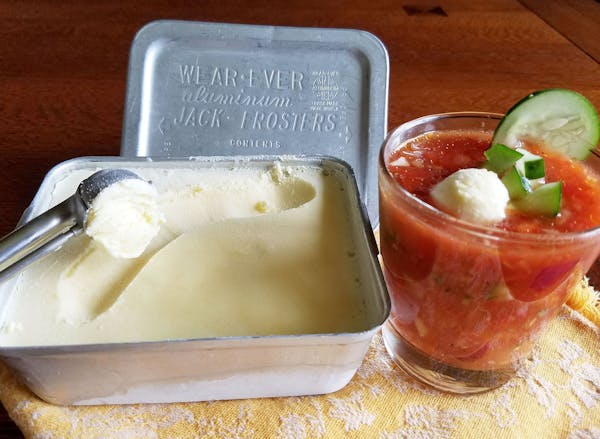Ice cream tip sheet
All you need to experiment at home is an ice cream freezer and a little time. Electric ice cream freezers are a readily available household appliance and a great improvement over the old-fashioned, hand-cranked style. You can buy a basic 1 1/2-quart ice cream freezer like my Cuisinart Frozen Yogurt, Ice Cream and Sorbet maker for around $50, or you can spend more and get super-efficient freezers with larger capacity, digital controls, timers and settings for ice cream, gelato or sorbet. These can run as high as $250. So far, I haven't found I needed the Cadillac of ice cream freezers to make great ice cream at home.
There are a few things that will make your ice cream experiments more successful.
Plan ahead. You have to pre-freeze the canister of the ice cream freezer for 6 to 24 hours before using it. Place it on a flat surface in its upright position for even freezing. In an upright freezer, place it toward the back of the freezer where it's the coldest. My freezer canister lives there full time, in a large zip-lock bag to keep it clean.
Have your ingredients ready. If you're making a cooked custard-style ice cream, be sure it's completely chilled or it will take longer to freeze. The faster you can freeze your ice cream mix, the smaller the ice crystals in the ice cream will be and you will have smoother, creamier ice cream. Have add-ins measured and nearby. Most add-ins get added to the canister just before the ice cream is completely frozen. If you add them as you start freezing, they will simply sink to the bottom.
Start freezing immediately after removing the canister from the freezer. Place the canister on the freezer, put the lid on top and start the machine running before you pour in the ice cream mixture. Once I added the mixture before turning on the machine and the dasher wouldn't move because some of the mixture had frozen to the side of the canister. (If this happens to you, dunk the canister in a bowl of very warm water just until you can use a spatula to scrape the ice cream away from the sides.)
Don't walk far away from the freezer; this isn't a set-it-and-forget-it process unless you have one of the high-end freezers with a countdown timer. Use your eyes and ears to tell when it's done. The churning noise will change pitch and the motor will begin to drag just a little as it's near the finish point. Most ice cream recipes will be done freezing in 20 to 30 minutes. It should look like soft serve ice cream. At this point you can let it harden a little more by letting it sit in the canister (with the motor off) before serving, or you can transfer it to an airtight container and freeze it.
LOANN MOCKLER
The National Enquirer was the go-to American tabloid for many years. Donald Trump helped change that
Animal groups are urging tourists not to visit Wyoming after a man hit a wolf then took it to a bar
Mexican film wins top prize at Moscow International Film Festival while major studios boycott Russia
Berkshire Hathaway's real estate firm to pay $250 million to settle real estate commission lawsuits

